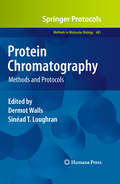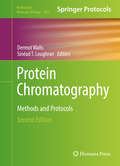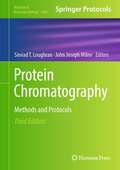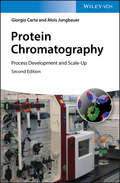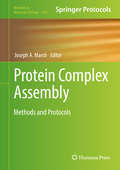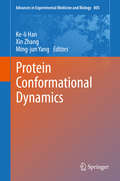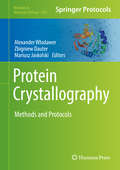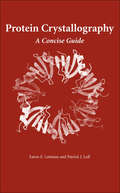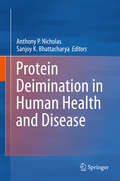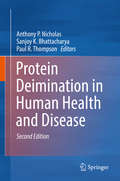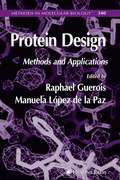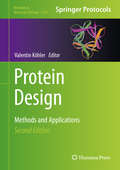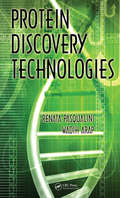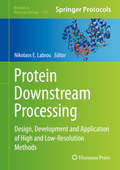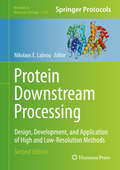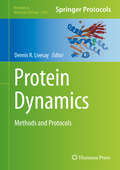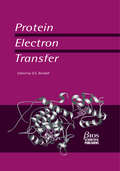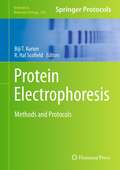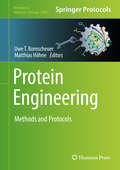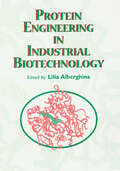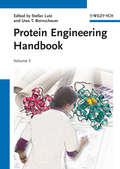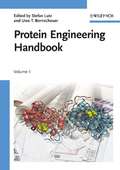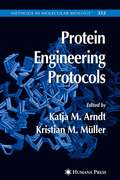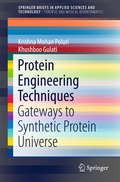- Table View
- List View
Protein Chromatography
by Sinéad T. Loughran Dermot WallsA prerequisite for elucidating the structure and function of any protein is the prior purification of that protein. This necessity has led to the development of many purification schemes and chromatographic methods for the isolation of native proteins from complex sources. In Protein Chromatography: Methods and Protocols, leading researchers present clear protocol-style chapters that are suitable for newcomers and experts alike. The book opens with vital topics in protein biochemistry, addressing such areas as protein stability and storage, avoiding proteolysis during chromatography, protein quantitation methods including immuno-qPCR, and the contrasting challenges that microfluidics and scale-up production pose to the investigator, and then it segues into key methods involving the generation and purification of recombinant proteins through recombinant antibody production and the tagging of proteins, amongst other means, as well as many variations on classic techniques such as ion-exchange and immunoaffinity chromatography. Written in the highly successful Methods in Molecular BiologyTM series format, protocols chapters include introductions to their respective subjects, lists of the necessary materials and reagents, step-by-step, readily reproducible laboratory protocols, and tips on troubleshooting and avoiding known pitfalls. Authoritative and up-to-date, Protein Chromatography: Methods and Protocols will greatly aid scientists in establishing these essential techniques in their own laboratories and furthering our understanding of the many imperative functions of proteins.
Protein Chromatography
by Sinéad T. Loughran Dermot WallsA prerequisite for elucidating the structure and function of any protein is the prior purification of that protein. This necessity has led to the development of many purification schemes and chromatographic methods for the isolation of native proteins from complex sources. In Protein Chromatography: Methods and Protocols, leading researchers present clear protocol-style chapters that are suitable for newcomers and experts alike. The book opens with vital topics in protein biochemistry, addressing such areas as protein stability and storage, avoiding proteolysis during chromatography, protein quantitation methods including immuno-qPCR, and the contrasting challenges that microfluidics and scale-up production pose to the investigator, and then it segues into key methods involving the generation and purification of recombinant proteins through recombinant antibody production and the tagging of proteins, amongst other means, as well as many variations on classic techniques such as ion-exchange and immunoaffinity chromatography. Written in the highly successful Methods in Molecular Biology(tm) series format, protocols chapters include introductions to their respective subjects, lists of the necessary materials and reagents, step-by-step, readily reproducible laboratory protocols, and tips on troubleshooting and avoiding known pitfalls. Authoritative and up-to-date, Protein Chromatography: Methods and Protocols will greatly aid scientists in establishing these essential techniques in their own laboratories and furthering our understanding of the many imperative functions of proteins.
Protein Chromatography: Methods and Protocols (Methods in Molecular Biology #2699)
by Sinéad T. Loughran John Joseph MilneThis third edition expands on the previous editions with updated and new chapters on protein chromatography. Chapters detail protein stability and storage, avoiding proteolysis, protein quantitation methods, generation and purification of recombinant proteins, recombinant antibody production, and the tagging of proteins. Written in the format of the highly successful Methods in Molecular Biology series, each chapter includes an introduction to the topic, lists necessary materials and reagents, includes tips on troubleshooting and known pitfalls, and step-by-step, readily reproducible protocols. Authoritative and cutting-edge, Protein Chromatography: Methods and Protocols, Third Edition aims to provide commonly used methods and new approaches to help both new researchers and experts expand their knowledge.
Protein Chromatography: Process Development and Scale-Up
by Giorgio Carta Alois JungbauerAn all-in-one practical guide on how to efficiently use chromatographic separation methods Based on a training course that teaches the theoretical as well as practical aspects of protein bioseparation to bioprocess professionals, this fully updated and revised new edition offers comprehensive coverage of continuous chromatography and provides readers with many relevant examples from the biopharmaceutical industry. Divided into two large parts, Protein Chromatography: Process Development and Scale-Up, Second Edition presents all the necessary knowledge for effective process development in chromatographic bioseparation, both on small and large scale. The first part introduces chromatographic theory, including process design principles, to enable the reader to rationalize the set-up of a bioseparation process. The second part illustrates by way of case studies and sample protocols how the theory learned in the first part may be applied to real-life problems. Chapters look at: Downstream Processing of Biotechnology Products; Chromatography Media; Laboratory and Process Columns and Equipment; Adsorption Equilibrium; Rate Processes; and Dynamics of Chromatography Columns. The book closes with chapters on: Effects of Dispersion and Rate Processes on Column Performance; Gradient Elution Chromatography; and Chromatographic Column Design and Optimization. -Presents the most pertinent examples from the biopharmaceutical industry, including monoclonal antibodies -Provides an overview of the field along with design tools and examples illustrating the advantages of continuous processing in biopharmaceutical productions -Focuses on process development and large-scale bioseparation tasks, making it an ideal guide for the professional bioengineer in the biotech and pharma industries -Offers field-tested information based on decades of training courses for biotech and chemical engineers in Europe and the U.S. Protein Chromatography: Process Development and Scale-Up, Second Edition will appeal to biotechnologists, analytical chemists, chromatographers, chemical engineers, pharmaceutical industry, biotechnological industry, and biochemists.
Protein Complex Assembly: Methods and Protocols (Methods in Molecular Biology #1764)
by Joseph A. MarshThis volume details the importance of multiple experimental techniques and computational methods needed to obtain the comprehensive picture of protein complex structure, dynamics and assembly afforded by the emerging field of integrative structural biology. Chapters guide readers through the broad spectrum of approaches required for a complete representation of protein complexes, including expression and purification, experimental characterization of structure and assembly, and computational methods for identifying protein complexes and modelling their assembly. Written in the highly successful Methods in Molecular Biology series format, chapters include introductions to their respective topics, lists of the necessary materials and reagents, step-by-step, readily reproducible laboratory protocols, and tips on troubleshooting and avoiding known pitfalls. Authoritative and cutting-edge, Protein Complex Assembly: Methods and Protocols aims to ensure successful results in the further study of this vital field.
Protein Conformational Dynamics
by Xin Zhang Ke-Li Han Ming-Jun YangThis book discusses how biological molecules exert their function and regulate biological processes, with a clear focus on how conformational dynamics of proteins are critical in this respect. In the last decade, the advancements in computational biology, nuclear magnetic resonance including paramagnetic relaxation enhancement, and fluorescence-based ensemble/single-molecule techniques have shown that biological molecules (proteins, DNAs and RNAs) fluctuate under equilibrium conditions. The conformational and energetic spaces that these fluctuations explore likely contain active conformations that are critical for their function. More interestingly, these fluctuations can respond actively to external cues, which introduces layers of tight regulation on the biological processes that they dictate. A growing number of studies have suggested that conformational dynamics of proteins govern their role in regulating biological functions, examples of this regulation can be found in signal transduction, molecular recognition, apoptosis, protein / ion / other molecules translocation and gene expression. On the experimental side, the technical advances have offered deep insights into the conformational motions of a number of proteins. These studies greatly enrich our knowledge of the interplay between structure and function. On the theoretical side, novel approaches and detailed computational simulations have provided powerful tools in the study of enzyme catalysis, protein / drug design, protein / ion / other molecule translocation and protein folding/aggregation, to name but a few. This work contains detailed information, not only on the conformational motions of biological systems, but also on the potential governing forces of conformational dynamics (transient interactions, chemical and physical origins, thermodynamic properties). New developments in computational simulations will greatly enhance our understanding of how these molecules function in various biological events.
Protein Crystallography
by Alexander Wlodawer Zbigniew Dauter Mariusz JaskolskiThis volume provides methods for modern macromolecular crystallography, including all steps leading to crystal structure determination and analysis. Written in the highly successful Methods in Molecular Biology series format, chapters include introductions to their respective topics, lists of the necessary materials and reagents, step-by-step, readily reproducible laboratory protocols, and tips on troubleshooting and avoiding known pitfalls. Authoritative and practical, Protein Crystallography aims to ensure successful results in the further study of this vital field.
Protein Crystallography: A Concise Guide
by Eaton E. Lattman Patrick J. LollThe proteome remains a mysterious realm. Researchers have determined the structures of only a small fraction of the proteins encoded by the human genome. Crystallography continues to be the primary method used to determine the structures of the remaining unknown proteins. This imaging technique uses the diffraction of X-rays to determine a protein’s three-dimensional molecular structure.Drawing on years of research and teaching experience, Eaton E. Lattman and Patrick J. Loll use clear examples and abundant illustrations to provide a concise and accessible primer on protein crystallography. Discussing the basics of diffraction, the behavior of two- and three-dimensional crystals, phase determination (including MIR and MAD phasing and molecular replacement), the Patterson function, and refinement, Lattman and Loll provide a complete overview of this important technique, illuminated by physical insights.The crisp writing style and simple illustrations will provide beginner crystallographers with a guide to the process of unraveling protein structure.
Protein Deimination in Human Health and Disease
by Anthony P. Nicholas Sanjoy K. BhattacharyaDeimination is a relatively new post-translational modification of proteins, whose recognition is ever-increasing. First linked to the pathology of rheumatoid arthritis (RA), deimination is a process by which selected positively charged arginine amino acids are converted to neutral citrulline amino acids by the peptidyl arginine deiminase (PAD) family of enzymes. Although the medical literature is rich with articles about the possible significance of deiminated proteins in RA, Protein Deimination in Human Health and Disease is the first publication to compile this knowledge and the growing amount of new information now known about the presence of deiminated proteins in the eye, skin, hair, gums, lung and nervous system, as well. As a result, this process has now been linked to numerous additional conditions besides RA, including cancer, glaucoma, Alzheimer's disease, Parkinson's disease, multiple sclerosis, spinal cord and peripheral nerve injury, Creutzfeldt-Jakob disease, among many others. Chronicling the earliest studies of deimination up to the present, this volume distills what is currently known about citrullination of proteins in the human body and is the first book of its kind on the topic.
Protein Deimination in Human Health and Disease
by Anthony P. Nicholas Sanjoy K. Bhattacharya Paul R. ThompsonPublished in 2014, Protein Deimination in Human Health and Disease was the first book on this novel post-translational modification, in which selected positively-charged arginine amino acids are converted to neutral citrulline amino acids by the peptidyl-arginine deiminase (PAD) family of enzymes. This area of research continues to expand rapidly, necessitating the need for this second edition. Chronicling the latest inflammatory, epigenetic, neurodegenerative, and carcinogenic processes, Protein Deimination in Human Health and Disease, Second Edition, updates the latest advances in deimination research, including new information on PAD enzyme structure and activity, and how PAD knock-out animals are being used to study known and newly-discovered links to various human diseases. The first edition outlined what was known about citrullinated proteins in normal tissues such as skin and hair, as well as in maladies such as rheumatoid arthritis (RA), multiple sclerosis (MS), Alzheimer's disease (AD), glaucoma, peripheral nerve injury, neonatal hypoxic brain damage, and breast cancer. This second edition addresses numerous additional disorders such as diabetes, asthma, traumatic brain injury, inflammatory bowel disease, lupus, bone disease, heart failure, fronto-temporal dementia, and prostate and colon cancer. It also provides updates on the deimination research covering the three seminal diseases first linked to this process (RA, MS and AD), and details how auto-antibodies against citrullinated proteins contribute to disease. In addition, new hypotheses on the possible pathologic mechanisms of citrullinated myelin basic protein and glial fibrillary acidic protein are also proposed. This second edition also outlines the latest developments in therapeutic strategies, including the use of new PAD antagonists and innovative techniques such as micro-vescicles and stem cells as possible mechanisms to treat these conditions.
Protein Design
by Raphael Guerois Manuela López de la PazProtein Design: Methods and Applications presents the most up-to-date protein design and engineering strategies so that readers can undertake their own projects with a maximum chance of success. The authors present integrated computational approaches that require various degrees of computational complexity, and the major accomplishments that have been achieved in the design and structural characterization of helical peptides and proteins.
Protein Design: Methods and Applications (Methods in Molecular Biology #1216)
by Valentin KöhlerProtein Design: Method and Applications, Second Edition expands upon the previous edition with current, detailed ideas on how to approach a potential protein design project. With new chapters on metals as structure-forming elements and functional sites, the design and characterization of fluorinated proteins, top-down symmetric deconstruction and the design of protein libraries and novel or repurposed enzymes. Written in the highly successful Methods in Molecular Biologyseries format, chapters include introductions to their respective topics, lists of the necessary materials and reagents, step-by-step, readily reproducible laboratory protocols, and tips on troubleshooting and avoiding known pitfalls. Thorough and intuitive, Protein Design: Method and Applications, Second Edition provides a number of practical protocols and instructive reviews to aid in the creation of new experiments.
Protein Discovery Technologies
by Renata Pasqualini Wadih ArapA True Insider's Guide to the Field - Then and Now Until now, there has not been a book that effectively addresses the historical basis of protein discovery. Featuring contributions from a distinguished international panel of experts, Protein Discovery Technologies elucidates the principles, techniques, strategies, and broad range of applications o
Protein Downstream Processing: Design, Development and Application of High and Low-Resolution Methods (Methods in Molecular Biology #1129)
by Nikolaos E. LabrouProteins are the most diverse group of biologically important substances. With the recent technological advances in the genomics area and the efforts in proteomics research, the rate of discovery for new proteins with unknown structure and function has increased. These proteins generated from genomic approaches present enormous opportunities for research and industrial application. Protein Downstream Processing: Design, Development and Application of High and Low-Resolution Methods is a compilation of chapters within the exciting area of protein purification designed to give the laboratory worker the information needed to design and implement a successful purification strategy. It presents reliable and robust protocols in a concise form, emphasizing the critical aspects on practical problems and questions encountered at the lab bench. Written in the successful Methods in Molecular Biology series format, chapters include introductions to their respective topics, lists of the necessary materials and reagents, step-by-step, readily reproducible protocols and notes on troubleshooting and avoiding known pitfalls. Authoritative and easily accessible, Protein Downstream Processing: Design, Development and Application of High and Low-Resolution Methods will be an ideal source of scientific information to advanced students, junior researchers, and scientists involved in health sciences, cellular and molecular biology, biochemistry, and biotechnology and other related areas in both academia and industry.
Protein Downstream Processing: Design, Development, and Application of High and Low-Resolution Methods (Methods in Molecular Biology #2178)
by Nikolaos E. LabrouThis second edition volume expands on the previous edition with updated research and techniques to help laboratory workers design and implement a successful purification strategy, emphasize critical aspects on practical problems, and answers questions encountered at the lab bench. The chapters in this book are divided into five parts: Part One discusses an overview of screening and design of purification strategies and covers initial aspects on high-throughput screening, methods development, and media selection; Parts Two and Three explore low- and high-resolution methods, with emphasis on affinity chromatography; Part Four describes analytical techniques of purified proteins; and Part Five presents selected examples and case studies to discuss the aforementioned. Written in the highly successful Methods in Molecular Biology series format, chapters include introductions to their respective topics, lists of the necessary materials and reagents, step-by-step, readily reproducible laboratory protocols, and tips on troubleshooting and avoiding known pitfalls.Authoritative and comprehensive, Protein Downstream Processing: Design, Development, and Application of High and Low-Resolution Methods, Second Edition is an ideal source of information to advanced students, junior researchers, and scientists involved in health sciences, cellular and molecular biology, biochemistry, biotechnology, and other related areas in both academia and industry.
Protein Dynamics
by Dennis R. LivesayIn Protein Dynamics: Methods and Protocols, expert researchers in the field detail both experimental and computational methods to interrogate molecular level fluctuations. Chapters detail best-practice recipes covering both experimental and computational techniques, reflecting modern protein research. Written in the highly successful Methods in Molecular Biology(tm) series format, chapters include introductions to their respective topics, lists of the necessary materials and reagents, step-by-step, readily reproducible laboratory protocols, and key tips on troubleshooting and avoiding known pitfalls. Authoritative and practical, Protein Dynamics: Methods and Protocols describes the most common and powerful methods used to characterize protein dynamics.
Protein Dysfunction in Human Genetic Disease
by Y. H. Edwards D. M. SwallowRecent years have seen rapid advances in our understanding of genetic diseases in terms of their molecular origins. The book focuses on DNA mutations which give rise to abnormalities of protein structure and function in genetic disease.
Protein Electron Transfer
by Derek S. BendallThis book is unique; the factual content and ideas it expounds are only just beginning to be touched upon in standard texts. Protein Electron Transfer is a major collaborative effort by leading experts and explores the molecular basis of the rapidly expan
Protein Electrophoresis
by Biji T. Kurien R. Hal ScofieldProteins are the functional units of the cellular machinery and they provide significant information regarding the molecular basis of health and disease. Therefore, techniques to separate and isolate the various proteins are critical to studying and understanding their functional characteristics. One of the widely used techniques for this purpose is electrophoresis. In Protein Electrophoresis: Methods and Protocols, contributions from experts in the field have been collected in order to provide practical guidelines to this complex study. Each chapter outlines a specific electrophoretic variant in detail so that laboratory scientists may perform a technique new to their lab without difficulty. Written in the successful Methods in Molecular BiologyTM series format, chapters include introductions to their respective topics, lists of the necessary materials and reagents, step-by-step, readily reproducible protocols, and notes on troubleshooting and avoiding known pitfalls. Authoritative and accessible, Protein Electrophoresis: Methods and Protocols seeks to serve laboratory scientists with well-honed, detailed methodologies in an effort to further our knowledge of this essential field.
Protein Engineering
by Uwe T. Bornscheuer Matthias HöhneThis volume details basic and advanced protocols for both stages of protein engineering: the library design phase and the identification of improved variants by screening and selection. Chapters focus on enzyme engineering using rational and semi-rational approaches. Written in the highly successful Methods in Molecular Biology series format, chapters include introductions to their respective topics, lists of the necessary materials and reagents, step-by-step, readily reproducible laboratory protocols, and tips on troubleshooting and avoiding known pitfalls. Authoritative and cutting-edge, Protein Engineering: Methods and Protocols aims to aid scientists in the planning and performance of their experiments.
Protein Engineering For Industrial Biotechnology
by Lilia AlberghinaProtein engineering has proved to be one of the more fruitful technological approaches in biotechnology, being both very powerful and able to generate valuable intellectual property. This book aims to present examples in which the application of protein engineering has successfully solved problems arising in industrial biotechnology. There is a sec
Protein Engineering Handbook: Volume 3
by Stefan Lutz Uwe T. BornscheuerThis introduction collects 17 innovative approaches to engineer novel and improved proteins for diverse applications in biotechnology, chemistry, bioanalytics and medicine. As such, key developments covered in this reference and handbook include de novo enzyme design, cofactor design and metalloenzymes, extremophile proteins, and chemically resistant proteins for industrial processes. The editors integrate academic innovations and industrial applications so as to arrive at a balanced view of this multi-faceted topic. Throughout, the content is chosen to complement and extend the previously published two-volume handbook by the same editors, resulting in a superb overview of this burgeoning field.
Protein Engineering Handbook: Volume 3
by Stefan Lutz Uwe T. BornscheuerUnparalleled in size and scope, this new major reference integrates academic and industrial knowledge into a single resource, allowing for a unique overview of the entire field. Adopting a systematic and practice-oriented approach, and including a wide range of technical and methodological information, this highly accessible handbook is an invaluable 'toolbox' for any bioengineer. In two massive volumes, it covers the full spectrum of current concepts, methods and application areas.
Protein Engineering Protocols
by Kristian Müller Katja ArndtProtein engineering is a fascinating mixture of molecular biology, protein structure analysis, computation, and biochemistry, with the goal of developing useful or valuable proteins. Divided into two sections, Protein Engineering Protocols reviews rational protein design strategies and directed evolutionary techniques, and their impact on protein engineering. The first section presents design and computational strategies for protein engineering focusing on designing a protein with desired properties, including examples covering a wide range of engineering techniques, such as protein-protein interactions, DNA binding, antibody mimics, and enzymatic activity. The second section on evolutionary techniques provides step-by-step instructions on library design and statistical assessment of library quality. New methods for DNA shuffling as well as different selection strategies are also presented. Following the successful Methods in Molecular BiologyTM series format, this volume provides a comprehensive guide to the methods used at every stage of the engineering process. By combining a thorough theoretical foundation with detailed protocols, Protein Engineering Protocols will be invaluable to all research workers in the area, from graduate students to senior investigators.
Protein Engineering Techniques
by Krishna Mohan Poluri Khushboo GulatiThis brief provides a broad overview of protein-engineering research, offering a glimpse of the most common experimental methods. It also presents various computational programs with applications that are widely used in directed evolution, computational and de novo protein design. Further, it sheds light on the advantages and pitfalls of existing methodologies and future perspectives of protein engineering techniques.
